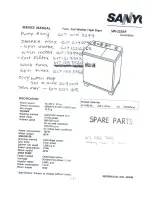
9
Must be fully extended and supported when the dryer is in its
N
final location.
Remove excess flexible metal vent to avoid sagging
N
and kinking that may result in reduced airflow and poor
performance.
Do not install flexible metal vent in enclosed walls, ceilings,
N
or floors.
The total length of flexible metal duct shall not exceed
N
7¾ ft. (2.4 m).
Elbows:
45° elbows provide better airflow than 90° elbows.
N
Clamps:
Use clamps to seal all joints.
N
Exhaust vent must not be connected or secured with screws
N
or other fastening devices that extend into interior of duct
and catch lint. Do not use duct tape.
Clamp
Exhaust:
Recommended hood styles.
Acceptable hood style.
4"
(102 mm)
2
½
"
(64 mm)
4"
(102 mm)
4"
(102 mm)
B
A
C
A. Louvered hood style
B. Box hood style
C. Angled hood style is acceptable
An exhaust hood should cap the vent to keep rodents and
N
insects from entering the home.
Exhaust hood must be at least 12" (305 mm) from the ground
N
or any object that may be in the path of the exhaust (such as
flowers, rocks or bushes, snow line, etc.).
Do not use an exhaust hood with a magnetic latch.
N
Improper venting can cause moisture and lint to collect
indoors, which may result in:
Moisture damage to woodwork, furniture, paint, wallpaper,
carpets, etc.
Housecleaning problems and health problems.
Good
Better
Plan Vent System
Recommended exhaust installations
Typical installations vent the dryer from the rear of the dryer.
Other installations are possible.
A
B
B
C
D
E
F
G
H
I
A. Dryer
B. Elbow
C. Wall
D. Exhaust hood
E. Clamps
F. Rigid metal or flexible metal vent
G. Vent length necessary to connect elbows
H. Exhaust outlet
I.
Optional side exhaust outlet
(27" wide models only)
Optional exhaust installations:
27" Wide Models can be converted to exhaust out the right
side, left side, or through the bottom. Each kit includes step-by-
step instructions. For further information, please reference the
“Assistance or Service” section of the “Dryer User Instructions.”










































